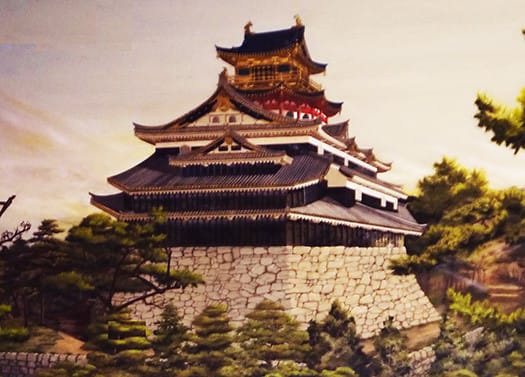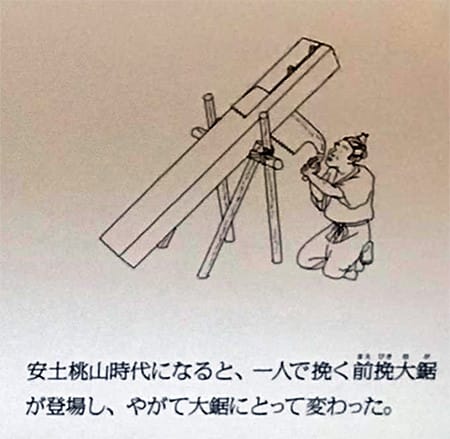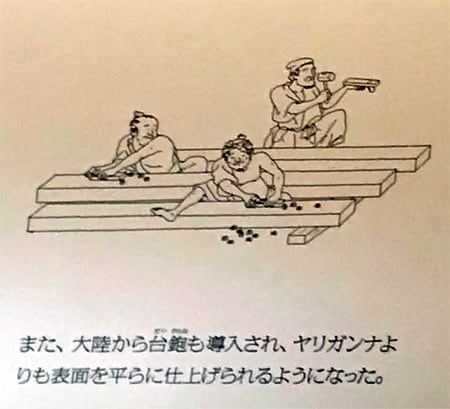


室町の世は戦国期を含めて人口増加の時代。
1115年の平安末期で724万人ほどだったものが、1600年段階で1390万人ほど。
500年間でほぼ人口倍増している。(上智大・鬼頭先生「歴史人口」資料より)
この歴史時間では各地方で自立的な経済圏が成立してその蜜を簒奪する武権も
同時に確立していった過程だといえるのでしょう。
関東平野などの未耕作地域が開墾されていって、各地域の発展が進んだ。
朝廷・皇統周辺での権力たらい回しと各地方への支配高等官派遣政治から
各地域権力者である武家がそれに支配されるバカらしさに気付いて
武力で権力を生み出していって、さらに地方の経済基盤を大きくした時代。
まことに「地方創生」が生き生きと展開していった時代でしょう。
封建というと否定的に捉えられるけれど、人類進歩では民主主義に向かう
必然的な社会プロセスが現出していった時代。戦国は
過酷な権力争奪の時代だけれど、地域発展の面では合理性が高いと思う。
極東アジア世界ではどうも日本だけが真正の「封建」を実現したのか。
きのう見たように、大鋸が木材の製材プロセスを一変させたことで、
従来からは隔絶したような木材生産が可能になったことで、
それを利用しての各地域での土木建築が活況を呈した。
戦争の攻防の要である城砦建築需要が盛り上がり、
しかもそれらがどんどん落城して常に需要の新陳代謝があった。
もしこの時代に建材商社があれば、ウハウハだったことでしょう(笑)。
まぁ戦争での景気なので笑い事ではないけれど、事実はそうでしょう。
ただ、首都京都では繰り返された戦火で都市家屋は繰り返し焼却され
安土桃山期になって建材不足、ヤマの森林不足が深刻化し、
北山に人工的に「杉山」が植林されたと言われ、それが北山杉という
ブランド林になっていったと言われる。
この逸話には日本の「市場価値」の真実があるように感じる・・・。
室町期に導入された大鋸はすぐに技術革新が起こってイラストのように
ひとりで操作する「前挽き大鋸」に進化して旺盛な需要に応えていった。
たしかに伐採地でか、建設地近くでかを問わず、2人1組の作業は
工程管理上、面倒だったことでしょう。必然的変化。
そして今日の「台カンナ」も導入されて木材加工技術はどんどん進化した。
こういう活況を呈した建築技術の発展の末に
写真のような「安土城」などの高層建築文化が盛り上がっていく。
そして一方では利休などの「数寄屋茶室」文化も併存した。
日本の木造建築が止揚されて独特の文化として成立していったのでしょう。
English version⬇
[Sengoku Economic Growth and Evolution of Building Tools / Good House in Japan ㊳-12]
The world of Muromachi is an era of population growth, including the Warring States period.
At the end of the Heian period in 1115, there were about 7.24 million people, but in 1600 there were about 13.9 million people.
The population has almost doubled in 500 years. (From Sophia University, Professor Kito's "Historical Population" material)
In this historical time, an independent economic zone is established in each region, and there is also the military power to steal the honey.
It can be said that it is a process that was established at the same time.
Uncultivated areas such as the Kanto Plain have been cleared, and the development of each area has progressed.
From the power circumvention around the imperial court and the imperial court and the politics of dispatching high-ranking officials to each region
Being aware of the stupidity of the samurai, who are the powers of each region, being dominated by it
An era in which power was created by force and the local economic base was further expanded.
It must be an era when "regional revitalization" was truly developed.
Feudalism is considered negative, but human progress is toward democracy.
An era when inevitable social processes emerged. Sengoku
Although it is an era of severe power struggle, I think it is highly rational in terms of regional development.
In the Far East Asian world, did Japan realize the genuine "feudalism"?
As we saw yesterday, Daigiri changed the lumbering process of wood.
By making it possible to produce wood that has been isolated from the past,
Civil engineering and construction in each area using it was booming.
Demand for fort construction, which is the cornerstone of the offense and defense of the war, has risen.
Moreover, they were steadily falling and there was always a metabolism of demand.
If there was a building materials trading company in this era, it would have been ugly (laughs).
Well, it's not a laugh because it's a war economy, but it's true.
However, in the capital city of Kyoto, urban houses were repeatedly incinerated due to repeated wars.
In the Azuchi-Momoyama period, the shortage of building materials and forests in Yama became more serious.
It is said that "Sugiyama" was artificially planted in Kitayama, which is called Kitayama cedar.
It is said that it has become a brand forest.
I feel that this anecdote has the truth of Japan's "market value" ...
Daigiri, which was introduced in the Muromachi period, soon undergoes technological innovation, as shown in the illustration.
It has evolved into a "front-ground Daigiri" that can be operated by itself, and has responded to strong demand.
Certainly, the work of a pair of people is done regardless of whether it is in a logging area or near a construction site.
It would have been troublesome in terms of process control. Inevitable change.
And today's "Tai Kanna" was also introduced, and the wood processing technology has evolved steadily.
At the end of the development of such a booming building technology
High-rise building culture such as "Azuchi Castle" as shown in the photo will rise.
On the other hand, "Sukiya tea room" culture such as Rikyu also coexisted.
It seems that Japanese wooden architecture was suspended and established as a unique culture.










